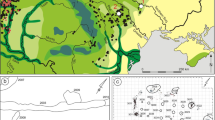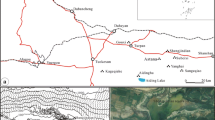Abstract
The Gumugou Cemetery is located in the Lop Nor region of the Tarim Basin in Xinjiang, northwest China. Radiocarbon dating found the site to be 3800 years BP. Due to the exceptionally arid conditions, most of the plant remains are well-preserved. Morphological and anatomical studies suggest that the plant remains consist of: Triticum cf. aestivum, Phragmites australis, Populus euphratica, Ephedra sp., as well as Typha sp. These ancient plants imply that the indigenous people lived in oases surrounded by extensive desert. Caryopses of T. cf. aestivum might have been used as funeral objects of the mummies as well as a subsidiary food source of the inhabitants, while the wild plants were used in other aspects of daily life.







Similar content being viewed by others
References
Aili A (2011) An exploration into the social life of prehistoric Lopnur. Master Thesis. Xinjiang Normal University, Urumchi, China (in Chinese with English abstract)
Bergman F (1939) Archaeological researches in Sinkiang: especially the Lop-Nor region. Bokforlags Aktiebolaget Thule, Stockholm
Bronk Ramsey C (2013) OxCAL v4.2.3. https://c14.arch.ox.ac.uk/oxcal/OxCal.html
Chen X (1995) Analysis of wood figurines discovered in the Gumugou cemetery. Huaxia Archaeol 2:71–77 (in Chinese with English abstract)
Cui Y, Duan R, Zhou H, Zhu H (2002) Analysis of genetical structure of the ancient Xinjiang population. Chem J Chin Univ 12:2278–2280 (in Chinese with English abstract)
Cui Y, Xu Y, Yang Y, Xie C, Zhu H, Zhou H (2004) Mitochondrial DNA polymorphism analysis of district of Lubunour at the Bronze Age in Xinjiang. J Jilin Univ Med Ed 4:650–652 (in Chinese with English abstract)
Fahn A, Werker E, Baas P (1986) Wood anatomy and identification of trees and shrubs from Israel and adjacent regions. The Israel Academy of Sciences and Humanities, Jerusalem
Frachetti DM, Spengler NR, Fritz JG, Mar’yashev NA (2010) Earliest direct evidence for broomcorn millet and wheat in the central Eurasian steppe region. Antiquity 84:993–1010
Han K (1986) Anthropological characters of the human skulls from the ancient cemetery at Gumugou, Xinjiang. Acta Archaeol Sin 3:361–384 (in Chinese with English abstract)
Han J (2008) The environment and cultural development in Pre-Qin northwestern China. Cultural Relics Press, Beijing (in Chinese)
Hillman GC, Mason S, Moulins D, Nesbitt M (1996) Identification of archaeological remains of wheat: the 1992 London workshop. Circaea 2:195–209
Jiang H (2006) The plant remains of the Yanghai tombs (2500 yrs B.P), and their relationship to the ancient Yanghai people and environment. Doctoral thesis. Graduate University of Chinese Academy of Sciences, Beijing, China (in Chinese with English abstract)
Li C, Li H, Cui Y, Xie C, Cai D, Li W, Mair VH, Xu Z, Zhang Q, Abuduresule I, Jin L, Zhu H, Zhou H (2010) Evidence that a West-East admixed population lived in the Tarim Basin as early as the early Bronze Age. BMC Biol 8:15
Li C, Lister DL, Li H, Xu Y, Cui Y, Bower MA, Jones MK, Zhou H (2011) Ancient DNA analysis of desiccated wheat grains excavated from a Bronze Age cemetery in Xinjiang. J Archaeol Sci 38:115–119
Li J, Idelisi A, Francis MH, Li W, Hu X, Li Y, Li C (2013) Buried in sands: environmental analysis at the archaeological site of Xiaohe Cemetery, Xinjiang, China. PLoS ONE 8(7), e68957
Liu X (2008) The preliminary study of human figurines recovered in prehistoric Xinjiang. Huaxia Archaeol 3:86–92 (in Chinese with English abstract)
Liu X, Li W (2012) New developments in the pre-historical archaeological researches of Xinjiang. J Xinjiang Univ Philos Humanit Soc Sci 40(1):1–7 (in Chinese with English abstract)
Liu J, Qin X (2005) Evolution of the environmental frame work and oasis in the Tarim Basin. Quat Sci 5:533–539 (in Chinese with English abstract)
Liu C, Jin G, Kong Z (2008) Archaeobotany—research on seeds and fruits. Science Press, Beijing (in Chinese)
Mair VH (2006) The rediscovery and complete excavation of Ördek’s necropolis. J Indo-Eur Stud 34:273–318
Mair VH (2010) The mummies of east central Asia. Expedition 52:23–32
Mallory JP, Mair VH (2008) The Tarim mummies: ancient China and the mystery of the earliest peoples from the West. Thames and Hudson Ltd, New York
Qi X, Wang B (2008) The ancient culture in Xinjiang along the Silk Road. Xinjiang People’s Publishing House, Urumchi
Qiu Z, Yang Y, Shang X, Li W, Yidilisi A, Hu X, Pan Y, Ferguson DK, Hu Y, Wang C, Jiang H (2014) Paleo-environment and paleo-diet inferred from Early Bronze Age cow dung at the Xiaohe Cemetery, Xinjiang, NW China. Quat Int. doi:10.1016/j.quaint.2014.03.029
Qu Y, Yang Y, Hu Y, Wang C (2013) The extraction and the C, N isotope analysis of hair keratin from Gumugou cemetery in Xinjiang. Geochimica 5:447–453 (in Chinese with English abstract)
Reimer PJ, Bard E, Bayliss A, Beck JW, Blackwell PG, Bronk Ramsey C, Buck CE, Cheng H, Edwards RL, Friedrich M, Grootes PM, Guilderson TP, Haflidason H, Hajdas I, Hatte C, Heaton TJ, Hoffmann DL, Hogg AG, Hughen KA, Kaiser KF, Kromer B, Manning SW, Niu M, Reimer RW, Richards DA, Scott EM, Southon JR, Staff RA, Turney CSM, van der Plicht J (2013) IntCal13 and Marine13 radiocarbon age calibration curves 0–50,000 years cal BP. Radiocarbon 55(4):1869–1887
Schweingruber FH (1990) Anatomy of European woods—an atlas for the identification of European trees, shrubs and dwarf shrubs. Haupt, Berne
Shao H (2009) Collision and fusion of the early culture between the East and the West. Soc Sci Front 9:146–150 (in Chinese)
Shu Q, Zhong W, Xiong H (2003) Study on the paleoclimatic evolution and vicissitude of human being’s civilization in Tarim Basin since about 4.0k years. Hum Geogr 18(3):87–91 (in Chinese with English abstract)
Song X (2009) Lop Nur area’s environmental variation during the different historical periods. Arid Land Geogr 1:107–111 (in Chinese with English abstract)
Tang Z, Chen D, Wu X, Mu G (2013) Redistribution of prehistoric Tarim people in response to climate change. Quat Int 308–309:36–41
Wang B (1983a) Archaeological excavations at Gumugou site, Kongque River and a preliminary study on the discoveries. Soc Sci Xinjiang 1:117–127 (in Chinese)
Wang B (1983b) Some problems about the social and cultural life of the man of the Gumugou. J Xinjiang Univ Philos Humanit Soc Sci 2:86–90 (in Chinese)
Wang B (2014) The Gumugou Cemetery. Xinjiang People’s Publishing House, Xinjiang (in Chinese)
Xia L (1997) Environmental accommodate of the ancient Loulan people: a consideration of the mortuary objects Ephedra of the Lop Nor. Soc Sci China 3:115–130 (in Chinese)
Xia X (2007) Lop Nur in China. Science Press, Beijing (in Chinese)
Xia X, Zhao Y, Wang F, Cao Q, Wei L (2008) Trace element content and its environmental significance in stratum near the earth’s surface at centre area of Lop Nur Lake. J Arid Land Resour Environ 22:137–141 (in Chinese with English abstract)
Xiao X (2013) Prehistoric culture of Tarim Basin: origins, characteristic sand relations. J Minzu Univ China Philos Soc Sci Ed 40(4):16–22 (in Chinese with English abstract)
Xie M, Yang Y, Wang B, Wang C (2013) Interdisciplinary investigation on ancient Ephedra twigs from Gumugou Cemetery (3800 b.p.) in Xinjiang region, northwest China. Microsc Res Tech 7:663–672
Yan S, Mu G, Xu Y (1998) Quaternary environmental evolution of the Lop Nur region, China. Acta Geograph Sin 55(4):332–340 (in Chinese with English abstract)
Yang R, Yang Y, Li W, Ydilisi A, Hu X, Wang C, Jiang H (2014) Investigation of cereal remains at the Xiaohe Cemetery in Xinjiang, China. J Archaeol Sci 49:42–47
Yidilis A, Liu G, Li W (2004) The excavation report of Xiaohe cemetery. Res China Front Archaeol 3:338–398 (in Chinese with English abstract)
Yidilis A, Li W, Hu X (2007) A brief excavation report on Xiaohe graveyard located in Luobupo, Xinjiang Autonomous Region. Cult Relics 10:4–42 (in Chinese with English abstract)
Zhang Y (2009) North Keriya Cemetery: an eternal mystery buried in the desert hinterland. Xinjiang Humanit Geogr 2:68–75 (in Chinese)
Zhang Q, Zhu H (2011) Carbon and nitrogen stable isotope analysis of the human bones from the Gumugou cemetery in Xinjiang: a preliminary exploration of the early population dietary in Lop Nur. W Reg Stud 3:91–96 (in Chinese with English abstract)
Zhang Q, Zhu H, Jin H (2006) Analysis of trace elements in Bronze Age human bone from Gumugou cemetery in Luobunaoer, Xinjiang. Archaeol Cult Relics 6:99–103 (in Chinese with English abstract)
Zhao K, Li X, Zhou X, Dodson J, Ji M (2012) Characteristics of agricultural activities and its impact on the environment at Xintala Site, Xinjiang, reconstructed from archaeological plant remains. Quat Sci 32:219–225 (in Chinese with English abstract)
Acknowledgments
We are grateful to Dr Benjamin Fuller for his kind help of revising this paper. This study was supported by the National Key Basic Research Program of China (2014CB954201), and the National Natural Science Foundation of China (Grant Nos. 41102114 and 41172164). Furthermore, the authors are grateful to the European Research Council project, Food Globalization in Prehistory (FOGLIP) for financial support for radiocarbon dating and to the members of FOGLIP for useful discussions.
Author information
Authors and Affiliations
Corresponding author
Rights and permissions
About this article
Cite this article
Zhang, G., Wang, S., Ferguson, D.K. et al. Ancient plant use and palaeoenvironmental analysis at the Gumugou Cemetery, Xinjiang, China: implication from desiccated plant remains. Archaeol Anthropol Sci 9, 145–152 (2017). https://doi.org/10.1007/s12520-015-0246-3
Received:
Accepted:
Published:
Issue Date:
DOI: https://doi.org/10.1007/s12520-015-0246-3




